
Microcline (KAlSi3O8) is an important igneous rock-forming tectosilicate mineral. It is a potassium-rich alkali feldspar. Microcline typically contains minor amounts of sodium. It is common in granite and pegmatites. Microcline forms during slow cooling of orthoclase; it is more stable at lower temperatures than orthoclase. Sanidine is a polymorph of alkali feldspar stable at yet higher temperature. Microcline may be clear, white, pale-yellow, brick-red, or green; it is generally characterized by cross-hatch twinning that forms as a result of the transformation of monoclinic orthoclase into triclinic microcline.
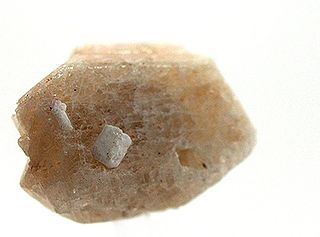
The mineral anorthoclase ((Na,K)AlSi3O8) is a crystalline solid solution in the alkali feldspar series, in which the sodium-aluminium silicate member exists in larger proportion. It typically consists of between 10 and 36 percent of KAlSi3O8 and between 64 and 90 percent of NaAlSi3O8.

Albite is a plagioclase feldspar mineral. It is the sodium endmember of the plagioclase solid solution series. It represents a plagioclase with less than 10% anorthite content. The pure albite endmember has the formula NaAlSi
3O
8. It is a tectosilicate. Its color is usually pure white, hence its name from Latin, albus. It is a common constituent in felsic rocks.
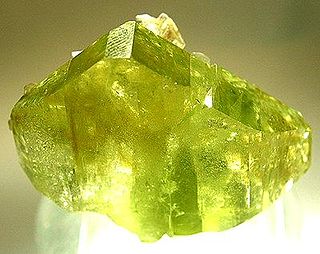
Brazilianite, whose name derives from its country of origin, Brazil, is a typically yellow-green phosphate mineral, most commonly found in phosphate-rich pegmatites.
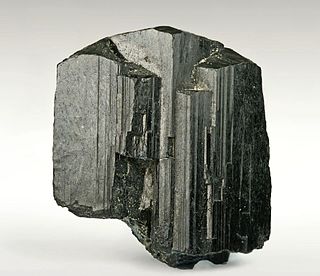
Arfvedsonite or soda hornblende (partiellement obsolète) is a sodium amphibole mineral with composition: [Na][Na2][(Fe2+)4Fe3+][(OH)2|Si8O22]. It crystallizes in the monoclinic prismatic crystal system and typically occurs as greenish black to bluish grey fibrous to radiating or stellate prisms.

Aenigmatite, also known as cossyrite after Cossyra, the ancient name of Pantelleria, is a sodium, iron, titanium inosilicate mineral. The chemical formula is Na2Fe2+5TiSi6O20 and its structure consists of single tetrahedral chains with a repeat unit of four and complex side branches. It forms brown to black triclinic lamellar crystals. It has Mohs hardness of 5.5 to 6 and specific gravity of 3.74 to 3.85. Aenigmatite forms a solid-solution series with wilkinsonite, Na2Fe2+4Fe3+2Si6O20.
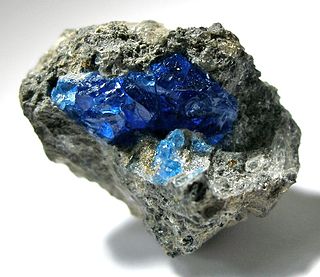
Hauyne or haüyne, also called hauynite or haüynite, is a Rare tectosilicate sulfate mineral with endmember formula Na3Ca(Si3Al3)O12(SO4). As much as 5 wt % K2O may be present, and also H2O and Cl. It is a feldspathoid and a member of the sodalite group. Hauyne was first described in 1807 from samples discovered in Vesuvian lavas in Monte Somma, Italy, and was named in 1807 by Brunn-Neergard for the French crystallographer René Just Haüy (1743–1822). It is sometimes used as a gemstone.

Vauxite is a phosphate mineral with the chemical formula Fe2+Al2(PO4)2(OH)2·6(H2O). It belongs to the laueite – paravauxite group, paravauxite subgroup, although Mindat puts it as a member of the vantasselite Al4(PO4)3(OH)3·9H2O group. There is no similarity in structure between vauxite and paravauxite Fe2+Al2(PO4)2(OH)2·8H2O or metavauxite Fe3+Al2(PO4)2(OH)2·8H2O, even though they are closely similar chemically and all minerals occur together as secondary minerals. Vauxite was named in 1922 for George Vaux Junior (1863–1927), an American attorney and mineral collector.

Ajoite is a hydrated sodium potassium copper aluminium silicate hydroxide mineral. Ajoite has the chemical formula (Na,K)Cu7AlSi9O24(OH)6·3H2O, and minor Mn, Fe and Ca are usually also present in the structure. Ajoite is used as a minor ore of copper.

Partheite or parthéite is a calcium aluminium silicate and a member of the zeolite group of minerals, a group of silicates with large open channels throughout the crystal structure, which allow passage of liquids and gasses through the mineral. It was first discovered in 1979 in rodingitic dikes in an ophiolite zone of the Taurus Mountains in southwest Turkey. The second discovery occurred in gabbro-pegmatites in the Ural Mountains, Russia. Since its discovery and naming, the chemical formula for partheite has been revised from CaAl2Si2O8·2H2O to include not only water but hydroxyl groups as well. The framework of the mineral is interrupted due to these hydroxyl groups attaching themselves to aluminum centered oxygen tetrahedra. This type of interrupted framework is known in only one other zeolite, the mineral roggianite. As a silicate based mineral with the properties of a zeolite, partheite was first described as zeolite-like in 1984 and listed as a zeolite in 1985. Partheite and lawsonite are polymorphs. Associated minerals include prehnite, thomsonite, augite, chlorite and tremolite.
Alluaivite is a rare mineral of the eudialyte group, with complex formula written as Na19(Ca,Mn)6(Ti,Nb)3Si26O74Cl·2H2O. It is unique among the eudialyte group as the only titanosilicate (other representatives of the group are usually zirconosilicates). The two dual-nature minerals of the group, being both titano- and zirconosilicates, are labyrinthite and dualite. They both contain alluaivite module in their structures. Alluaivite is named after Mt. Alluaiv in Lovozero Tundry massif, Kola Peninsula, Russia, where it is found in ultra-agpaitic, hyperalkaline pegmatites.

Tsumebite is a rare phosphate mineral named in 1912 after the locality where it was first found, the Tsumeb mine in Namibia, well known to mineral collectors for the wide range of minerals found there. Tsumebite is a compound phosphate and sulfate of lead and copper, with hydroxyl, formula Pb2Cu(PO4)(SO4)(OH). There is a similar mineral called arsentsumebite, where the phosphate group PO4 is replaced by the arsenate group AsO4, giving the formula Pb2Cu(AsO4)(SO4)(OH). Both minerals are members of the brackebuschite group.

Tuperssuatsiaite is a rare clay mineral found in Greenland, Namibia and Brazil. It is a hydrated phyllosilicate of sodium and iron.

Magnesiohastingsite is a calcium-containing amphibole and a member of the hornblende group. It is an inosilicate (chain silicate) with the formula NaCa2(Mg4Fe3+)(Si6Al2)O22(OH)2 and molar mass 864.69 g. In synthetic magnesiohastingsite it appears that iron occurs both as ferrous iron Fe2+ and as ferric iron Fe3+, but the ideal formula features only ferric iron. It was named in 1928 by Marland P. Billings. The name is for its relationship to hastingsite and its magnesium content. Hastingsite was named for the locality in Dungannon Township, Hastings County, Ontario, Canada.

Leifite is a rare tectosilicate. Tectosilicates are built on a framework of tetrahedra with silicon or aluminium at the centre and oxygen at the vertices; they include feldspars and zeolites, but leifite does not belong in either of these categories. It is a member of the leifite group, which includes telyushenkoite (Cs,Na,K)Na6(Be2Al3Si15O39) and eirikite KNa6Be2(Si15Al3)O39F2). Leifite was discovered in 1915, and named after Leif Ericson who was a Norse explorer who lived around 1000 AD, and was probably the first European to land in North America, nearly 500 years before Christopher Columbus. Eirikite was named in 2007 after Eirik Raude, or Erik the Red, (950–1003), who discovered Greenland and who was the father of Leif Ericson. The third mineral in the group, telyushenkoite, was discovered in 2001. It was not named after any of Leif Ericson's family members, but after a professor of geology in Turkmenistan.

Tumchaite, Na2(Zr,Sn)Si4O11·H2O, is a colorless to white monoclinic phyllosilicate mineral. It is associated with calcite, dolomite, and pyrite in the late dolomite-calcite carbonatites. It can be transparent to translucent; has a vitreous luster; and has perfect cleavage on {100}. Its hardness is 4.5, between fluorite and apatite. Tumchaite is isotypic with penkvilksite. The structure of the mineral is identified by silicate sheets parallel {100}, formed by alternation of clockwise and counterclockwise growing spiral chains of corner-sharing SiO4 tetrahedra. Tumchaite is named for the river Tumcha near Vuoriyarvi massif.
Voronkovite is a very rare mineral of the eudialyte group with the chemical formula Na15(Na,Ca,Ce)3(Mn,Ca)3Fe3Zr3Si2Si24O72(OH,O)4Cl·H2O. The formula is based on the simplified original one; it does not show the presence of cyclic silicate groups, but two M3- and M4-site silicon atoms are shown separately (basing on the nomenclature of the eudialyte group). Voronkovite has lowered symmetry (space group R3, instead of more specific for the group R3m one), similarly to some other eudialyte-group members: aqualite, labyrinthite, oneillite and raslakite. The specific feature of voronkovite is, among others, strong enrichment in sodium.
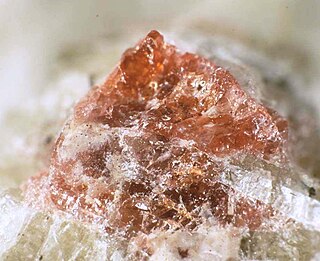
Raslakite is a rare mineral of the eudialyte group with the chemical formula Na15Ca3Fe3(Na,Zr)3Zr3(Si,Nb)SiO(Si9O27)2(Si3O9)2(OH,H2O)3(Cl,OH). This formula is based on the original one, and is extended to show the presence of cyclic silicate groups. The additional silicon and oxygen shown in separation from the cyclic groups are in fact connected with two 9-fold rings. The mineral has lowered symmetry, similarly to some other eudialyte-group members: aqualite, labyrinthite, oneillite and voronkovite. The specific feature of raslakite is, among others, the presence of sodium and zirconium at the M2 site. Raslakite was named after Raslak Cirques located nearby the type locality.

Serrabrancaite is a mineral with the chemical formula MnPO4•H2O and which is named for the locality where it was found, the Alto Serra Branca Pegmatite. The Alto Serra Branca mine has been in operation since the 1940s. It is located in Paraiba, Brazil near a village named Pedra Lavrada. Tantalite is the main mineral mined here. Specimens of serrabrancaite are kept in the Mineralogical Collections of both the Bergakademie Freiberg, Germany and the Martin-Luther Universität Halle, Institut für Geologische Wissenschaften.

Lomonosovite is a phosphate–silicate mineral with the idealized formula Na10Ti4(Si2O7)2(PO4)2O4 early Na5Ti2(Si2O7)(PO4)O2 or Na2Ti2Si2O9*Na3PO4.


















